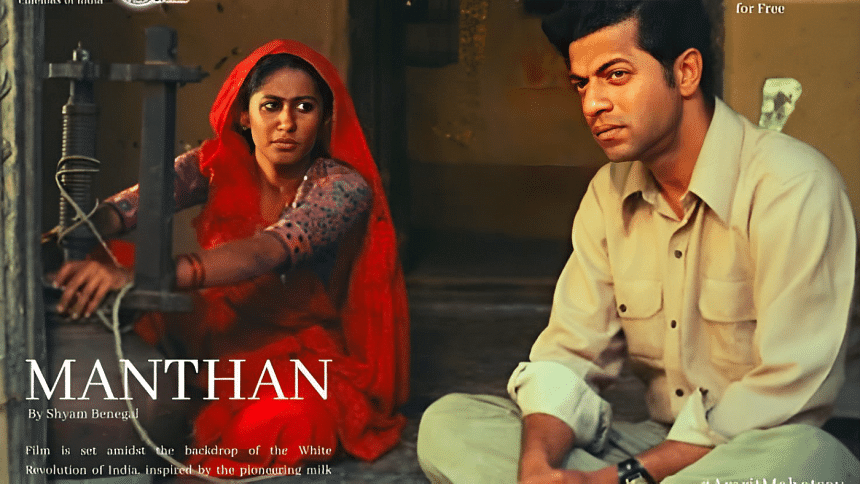Manthan: Indian film by half-a-million farmers spellbinds Cannes

In the mid-1970s, half a million dairy farmers from Gujarat, India, each contributed Rs 2 to create a ground-breaking film titled "Manthan" (The Churning). Directed by esteemed filmmaker Shyam Benegal, it became India's first crowd-funded film.

This 1976 film, running 134 minutes, narrates a fictionalised account of the inception of a dairy cooperative movement that transformed India from a milk-deficient nation into the world's leading milk producer. The story was inspired by Verghese Kurien, the "Milkman of India," who revolutionized the country's milk production, making India account for nearly a quarter of global milk production today.

Nearly 50 years later, a pristinely restored "Manthan" has appeared for a red-carpet world premiere at the Cannes Film Festival on Friday (May 18), alongside classics from Jean-Luc Godard, Akira Kurosawa, and Wim Wenders. According to Shivendra Singh Dungarpur, an award-winning filmmaker, archivist, and restorer, restoring the film posed significant challenges, reports BBC.

The only remaining materials were a damaged negative and two faded prints. The negative, ravaged by fungus, displayed vertical green lines across many sections, while the sound negative was entirely destroyed. The restorers had to rely on the sound from the sole surviving print.

The team salvaged the negative and one print, digitized the sound, and repaired the film. The scanning and digital clean-up were conducted at a Chennai lab under the supervision of a renowned Bologna-based film restoration lab, with Benegal and his long-time cinematographer Govind Nihalani overseeing the project. The film's sound was restored and enhanced at the Bologna lab.

Seventeen months later, "Manthan" was reborn in ultra-high definition 4K. Benegal, a doyen of Indian cinema, expressed his joy by stating ''It is wonderful to see the film come back to life almost like we made it yesterday. It looks better than the first print,'' said the 89-year-old filmmaker.

Benegal recalled that, encouraged by Kurien, he had produced several documentaries on Operation Flood—India's milk revolution—and rural marketing initiatives. When he suggested making a feature film to Kurien, the latter balked due to a lack of funds and his refusal to accept money from farmers.

Under the cooperative model, small farmers sold milk to a network of collection centers in Gujarat, which then transported the milk to dairies for processing. Kurien proposed that the centers deduct two rupees from each farmer, enabling them to collectively finance the film.
''The farmers readily agreed because we were telling their story,'' Benegal said.
"Manthan" featured a stellar cast, including Girish Karnad, Smita Patil, Naseeruddin Shah, Amrish Puri, Kulbhushan Kharbanda, and Mohan Agashe. The screenplay was based on a script by renowned playwright Vijay Tendulkar, and the music was composed by Vanraj Bhatia.

The film portrays a government veterinary doctor and his team who arrive in a divided village in Gujarat to start a dairy cooperative. As they work, they face resistance from a private dairy owner, the village head, and a volatile local milkman.
''Manthan is a microcosmic picture of transformative politics... Benegal offers a brilliant social critique of a situation in which government bureaucrats enter a village and try to change the social and economic perspectives of its inhabitants,'' wrote Sangeeta Datta, author of "World Director Series: Shyam Benegal".

The 45-day shoot was challenging due to tight finances. Nihalani recalled using a "patchwork of different film stocks" to complete the film. The crew lived as a close-knit family in the village, where many residents acted in the film. The cast wore the same costumes throughout to maintain authenticity, as Datta noted.
Many villagers from Gujarat participated in the film, which was produced by milk farmers. Naseeruddin Shah, who began his career with Benegal and later became one of India's most renowned actors, vividly remembers the experience. ''I lived in a hut, learnt to make cow dung cakes and how to milk a buffalo,'' he said. ''I would carry the buckets and serve the milk to the unit to get the physicality of the character.'' Shah, who will present the film at Cannes, also wore the same cotton shirt throughout the shoot.

The film's initial release in Gujarat was met with enthusiasm. ''The film did brilliantly because its largest audience was also the film's producers. Every day we had this incredible sight of truckloads of people coming in from all over to see the film,'' Benegal recounted. More copies of "Manthan" were produced than any other film in India, spanning formats from 35mm to 8mm, Super 8, and later, video cassettes. "Manthan" was shown worldwide, including at the UN General Assembly, and won a National Award in India.
The success of "Manthan" inspired Kurien to further propagate the milk revolution. He distributed 16mm prints of the film to villages nationwide, encouraging farmers to establish their own cooperatives. Reflecting reel life, Kurien sent teams comprising a vet, a milk technician, and a fodder specialist to show the film and guide the farmers.

Benegal asserts that "Manthan" serves as a powerful reminder of cinema's ability to drive change. The film remains relevant today as it explores enduring issues in contemporary India.
The film opens with a scene of a passenger train arriving at a tranquil village station, carrying the vet and his assistant. Locals rush down the platform to welcome their guests with garlands.
''We are sorry,'' a breathless villager tells the vet. ''The train arrived on time.''

 For all latest news, follow The Daily Star's Google News channel.
For all latest news, follow The Daily Star's Google News channel. 










Comments